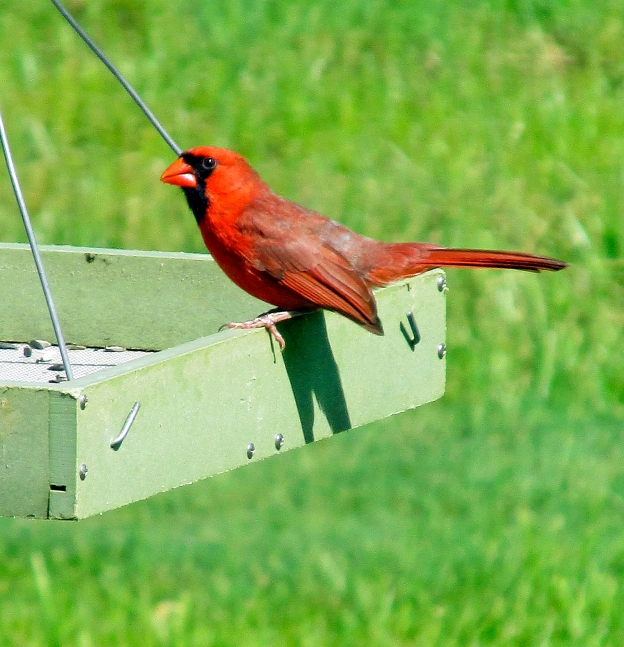
Photo Courtesy of Gina Fannin • This female Northern cardinal, with a head devoid of feathers, appeared at a home in Cincinnati, Ohio. Although these strange looking cardinals often surprise people, they are not all that uncommon in late summer.
Gina Fannin wrote about an unusual observation of a follicly challenged Northern cardinal at her home in Cincinnati, Ohio. The bird in question, a female cardinal, had lost most of the feathers on her head. Gina took a photo of the bird, which she sent with her email, in which she asked if I have ever encountered a cardinal with such a problem.
Gina said that she has seen male cardinals suffering from baldness, but never a female. “I’ve lived here 24 years, and this is the first time I’ve seen a bald female,” she wrote in her email.
I replied to Gina by informing her that I’ve heard of these strange instances for many years. Bald-headed cardinals seem to be a summer occurrence. I usually get some emails or calls this time of year about people surprised by visits from “weird bald-headed” cardinals. I first began to get calls and email from readers in the late 1990s about this unusual phenomenon that seems to usually afflict cardinals, although I have also seen blue jays suffering from this same ailment.

Photo by Bryan Stevens • This female Northern cardinal, shown with one of her offspring at a feeder in late summer, is exhibiting some problems with her feather molt.
I have studied the opinions of various bird experts, but there doesn’t seem to be consensus about the cause. Some believe the “baldness” is caused by an infestation of mites, which are small relatives of spiders and other arachnids. Others believe that the loss of feathers around the head is a part of a normal molting process. This theory is supported by the fact that cardinals do undergo molting in late summer, usually after the conclusion of the nesting season.
The process of molting removes old feathers, which simply drop from the body as new feathers emerge to take their place. For some reason, some cardinals and jays lose all their head feathers at one time before new feathers are ready to take their place. That’s why the condition is typically observed in the summer months. Both male and female cardinals can be afflicted with “bald” heads. It’s strange that the condition primarily affects these two birds, cardinals and jays, both of which have feather crests. On the other hand, cedar waxwings are also crested birds, but I have never observed or received a report on a “bald-headed” cedar waxwing.
Whatever the cause, a “bald-headed” cardinal is an ugly bird. Without feathers, a cardinal is transformed from a showy favorite among bird enthusiasts to a rather grotesque oddity that could aptly be described as resembling a scavenging vulture. Birds like vultures, however, have heads devoid of feathers for a very important reason: As scavengers, a feathered head would become quickly fouled as the bird reaches into the carcasses of dead animals to feed.
The cardinals I have seen with “bald” heads have been visiting feeders stocked with sunflower seeds or perhaps a holder offering a suet cake. So, the absence of feathers is not a hygienic adaptation on the part of cardinals and jays similar to the hygienic necessity of bald heads among vultures. The good news is that the condition is temporary. The normal molt for a Northern cardinal takes two or three months. The feathers on the head do emerge eventually, which is probably very fortunate for the afflicted birds. Feathers serve as insulation during cold weather. A “bald-headed” cardinal would probably have difficulty surviving winter cold spells.
We’re all accustomed to seeing cardinals at our feeders, but people who feed birds would probably be surprised by how much food cardinals and other feeder visitors obtain away from our well-stocked offerings. During the summer months, cardinals eat a variety of wild seeds, fruit and insects. Some of the fruit consumed by cardinals include elderberry, dogwood, blackberry and wild grapes. Young cardinals still in the nest (and fledglings for some time after leaving the nest) are fed mostly insects, including crickets, spiders, moths and flies.
To make cardinals comfortable in every season, offer plenty of thick vegetation, such as a hedge or row of shrubs, and consider planting some of the fruit trees and shrubs that will help these beautiful birds supplement their diet.




